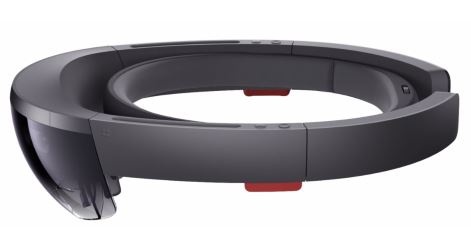For many years, the special projects group at Wargaming - makers of World Of Tanks and other military action games - have supported historical projects. They brought World War I machines to the streets of London last year to celebrate the 100th anniversary of the first tanks on the battlefield. They've partnered with Bovington's world famous tank museum on many activities.
Now they're returning there with cutting-edge AR tech. Their mission? Add a virtual tank to this year's Tiger exhibition. The Sturmtiger is so rare that it couldn't physically be part of Bovington's display, but guests will be able to witness it virtually. We spoke to Matt Daly, Special Projects Lead of Marketing Projects at Wargaming, about using gaming tech to create historical experiences...
Talk us through the AR Sturmtiger experience? What have you created?
MATT DALY: We took two next-gen augmented reality platforms: Microsoft HoloLens and the Google Tango platform. We put the HoloLens on and started playing with Tango some time last year, kind of in this dank, dingy castle in the middle of nowhere in Belarus! The tracking was really out of this world, considering that it wasn’t using any assistance whatsoever, except having to be able to visually look at the room around it. We were impressed by the devices, and we’ve been thinking, “How can we meaningfully use these?” Because our M.O. with Wargaming special projects is to explore the frontier of new media: where it intersects interestingly with heritage storytelling. Tech and heritage: it’s what defines the organisation.
We did our first VR project with [Bovington tank museum] three years ago. There were a lot of other projects and sponsorships and events with them. We knew they were building this Tiger exhibition, and they were logistically having a hard time completing it with the Sturmtiger, the super-rare rocket launcher tank. So we saw an immediate connection there and thought, “Well, this is the perfect opportunity for us to tell an interesting story and have an actual practical solution in place for a problem.” The problem being that the physical tank couldn’t be there!
The devices work exceptionally well, rendering objects as large as humans. We wondered how well they'd work when rendering an object as large as a tank! We weren’t sure how good or how effective it would be, considering the scale. They’re quite large vehicles, particularly a Sturmtiger, which is built on the same chassis as a Tiger I. It's just a massive, crazy piece of kit.
So we did some initial tests, rendering out the static 3D model. Its a legacy model, actually, from World Of Tanks! We used to have a Sturmtiger in-game, and you could also see it as an Easter egg in a map that was also discontinued. So effectively, it could no longer be publicly accessed in-game, but we still had the 3D asset. So we took it, and we could draw both of them into an AR space with the HoloLens and the Tango. We dropped it into an AR space for the devices, and it worked really well. There was no frame rate dropping. The object stayed quite firmly in place, which is the key to this whole next leap forward in augmented reality and mixed reality. It’s machine vision and depth-sensing. The devices do an extremely good job of keeping the things fixed in place.
We brought that to the Tank Museum and dropped this full-sized AR tank hologram into the middle of the floor of the exhibition – the then-in-construction exhibition space. And they were just extremely excited. And that was the beginning.
What’s so special about the Sturmtiger? Why is it so rare?
The Tiger collection itself is five tanks, but the sixth was planned to be the Sturmtiger. All the vehicles are pretty rare and exceptional examples of industrial design. The Tiger collection and the German World War 2 tanks – they’re legendary in their own right. They were impractical in many ways. They’re amazing machines, but prone to failure and very difficult to maintain in the field. It’s hard to produce many of them. So it’s just a war of numbers that they lost on the tank front.
The difference between me telling you about this, and you sitting inside an AR experience [is] just a drastically different and more engaging experienceMatt Daly
But the Sturmtiger specifically was built during a time when the Germans believed that they were going to be on the offensive, and based off of their not-so-pleasant experience at Stalingrad, they decided they needed a mobile bunker-buster. From an industrial war machine design standpoint, they said, “Well, what do we have that can potentially carry an extremely heavy armoured rocket launcher?” And they decided on the Tiger 1 chassis engine and suspension. So they took that and basically beheaded her and sort of carved out the interior space to make as much space as possible to carry as much rocket payload as possible. And what resulted was sort of this Franken-Tiger, that was like Tiger I from the neck down, and from the neck up it was this fixed casemate armament that had a modified rocket launcher built into it. It’s really out of this world, from an engineering standpoint.
The defence rocket launchers were basically like anti-submarine armament. The problem with putting that thing on a Tiger is that the entire crew was within inches of the exhaust of the rocket launcher. So they did all these crazy modifications so that the exhaust would recirculate out of these holes at the front of this very strange, snub-nose rocket launcher barrel. Rockets are extremely heavy. You needed a crane permanently fixed to the tank so that you could load them from the side. It was a great, arduous and laborious process.
The difference between me telling you about this, and you sitting inside an AR experience – particularly sitting right there next to the actual Tiger I – is a pretty good way of demonstrating how we feel this type of experience! It’s just a drastically different and more engaging experience. It’s one of the reasons we did it.
That’s the power of AR, isn’t it? You can see right inside the tank. That's why you've embraced it as a heritage tool?
Definitely. And the tank example is a good example. Despite the fact that it’s this heavily armoured war beast, the museum treats it as if it’s a Fabergé egg or something. They don’t allow anyone on top of that. If you need to climb on top of it, you need the supervisor. It’s not a vehicle that people can get up around, on top of, or inside of. So the AR version of its sister tank, sitting next to the real Tiger I… we can actually say the word “augmented” with a straight face, because it’s an applicable term in this case! You are not replacing the experience of the real thing, but literally putting the sister variants next to it at scale, as an experiential augmentation to how you’re perceiving the physical thing next to it. It’s not just the AR object; it’s how the AR object interacts with the environment. That’s, again, an applicable buzzword that we can use with a straight face. It’s mixed reality, literally.

How long did it take for you to create this?
Once we started in earnest with testing and development, it was a four-month development process. I am not at liberty to say what we spent on it, but it was, compared to almost any other heritage new media activity you can think of, it was astonishingly affordable.
Wargaming’s primarily a games business. Why invest that time, money and expertise in building an educational tool?
A priority for the company is “player happiness”. For years we’ve been making historical documentaries. You can find them all over YouTube. In many cases, if you search for a tank model or a ship or a plane, there’s a good chance that the first result you’ll see is something related to something we produced. Whether it’s an article or a video or a documentary or one of our projects, there’ll be something we curated or partnered with someone on. The new media side has, for a long time, been a logical extension of the same ethos that makes us produce these historical documentaries. We have a huge online, switched-on, digital native gamer population that’s a mix of people who came to the game because they’re gamers – it’s a fun game – and those that maybe wouldn’t even be defined as gamers, but came in because of the history (and found that the game was incredibly fun to play).
If you’re a gamer, like I am, you can think of many situations where you’ve learned about vernacular or acronyms or concepts about militia or weapons or theology! There are many different things that you learn by absorbing them passively through the experience of gameplay. So the audience we have is increasingly interested in the subject matter. They have a reason and a concrete attachment to specifically the vehicles.
We take you to parts of the ship which you couldn’t access before. For us, that direct engagement with the subject matter is going to become increasingly a core part of learningMatt Daly
For instance, if the Tiger I is one of your favourite vehicles in a game that you play frequently, then you’ll have that much of a personal connection with the real thing. If you go and see the real thing, that personal context and connection helps you connect with it, and understand what you’re looking at, and you appreciate it more. And you’re more curious about it. We find that audiences are super-curious about this stuff. And we expand that, on the heritage side. The job for us is to take that same sort of interest and engagement, and then expand on it. As we continue creating these case studies, documenting and observing, then we share that back with our R&D team; we share it back with our product team; and we hopefully contribute.
What's your own background and connection with this process?
The heritage side is actually the most recent thing for me. All of my background is in multimedia: radio, television, film, new media. I’ve been working for Wargaming for four or five years. I’m a pretty good example of this digital native gamer techie person, and I was given a context to care more about the historical side. For instance: walking around battlefields, climbing around tanks, walking around ships, next to the men and women that served on them or around them. Now I have this super-deep context, and I care much more about the history.
What we’re trying to do with AR and VR specifically with a lot of these special project activities, is trying to create a similar kind of intimate experience with our communities and with our audiences in a way that I experienced. I’m lucky to have experienced it because it’s rare, and it’s not something you can deliver. You can’t put millions and millions of people through that same experience with the same veteran. We take you to parts of the ship, like the engine room, which you couldn’t access before. For us, that intimacy, that direct engagement with the subject matter and the people in it, is going to become increasingly a core part of learning, retention, education. It’s really cool to be a part of that in a very unique sort of situation of being a games developer and publisher, by addressing this sort of huge online population, and then the general public.
What are you working on next?
We’re looking right now at ARKit. I can’t say that it’s going to happen, but ARKit is extremely interesting to us. Obviously, the big “but”, the big potential barrier to entry with this experience is that nobody has these devices. Very few people have HoloLenses. There’s no real addressable market. But we’re not even releasing the app right now, because so few people would be able to experience it. So ARKit is interesting to us: as soon as there is an addressable market for us to share this with, we want people to have this experience on their own. To not just have to visit a specific place to experience it or watch the case study that we’ve produced, or hear about it or have us describe it. We really want as many people as possible to be able to experience it. As soon as Apple starts throwing its weight into the arena, we’re interested in getting the experience on that platform, so that more people can actually directly experience it.
Find out more about the Sturmtiger experience at Bovington at the official tank museum website. Wargaming's Tracy Spaight will be speaking on this topic at XR Connects Helsinki, September 19-20, alongside other AR talks. Tickets are available now.













